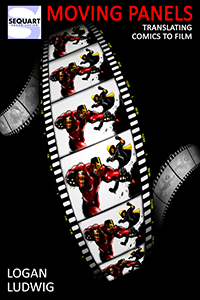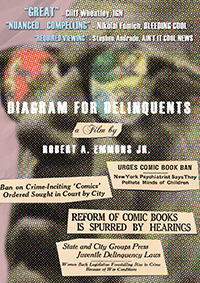My wife outright refuses to read the Black Freighter portions of Watchmen. Every time I press her on the issue, she complains, “They’re boring! I don’t want to read about pirates!”
I have a nearly perfect marriage with one exception: my wife and I fight about comics. I’ll never forget our first fight, back when we were dating, over Kingdom Come. We’ve fought over which version of the Flash we prefer, whether or not Batman Begins was a good movie, and who is the best female role-model in the DC Universe.
One of our more memorable brawls was over the subject of the Black Freighter.
“But the Black Freighter is essential to the overall story,” I tried to explain.
“It isn’t essential! I understood the story just fine without reading some boring story about pirates. It’s completely unnecessary, wordy, and it makes me fall asleep.”
 It wasn’t until we sat down and watched the Ultimate Cut of Watchmen the film that she finally saw the whole story of the Black Freighter, but it doesn’t do the story justice. Within the context of the Ultimate Cut, the Black Freighter loses all of its subtext. In the movie, the Black Freighter is nothing more than a pirate story.
It wasn’t until we sat down and watched the Ultimate Cut of Watchmen the film that she finally saw the whole story of the Black Freighter, but it doesn’t do the story justice. Within the context of the Ultimate Cut, the Black Freighter loses all of its subtext. In the movie, the Black Freighter is nothing more than a pirate story.
To be clear: the Black Freighter is so much more than just a simple story about pirates.
All at once, the Black Freighter is a metaphor for escapism, for art reflecting life, for the journey of Ozymandius, and so much more. Above all, if Watchmen is a metaphor for art reflecting life of 1980s, then the Black Freighter is a metaphor for art reflecting art of the time.
Not only is the Black Freighter essential to the overall world of Watchmen, it also elevates the comic and makes it literary. While it may seem like merely a story about pirates, this simple tale allows for the work to become meta-critical. The Black Freighter allows for Moore to comment on the state of comic books and the state of the world.
Escapism
Super-hero comic books provide escapism for many readers, but in a world populated by superheroes, where can readers escape? The answer is: pirate comic books.
The first page of issue three begins with haunting narration from the Black Freighter comic book. “Delirious, I saw that Hell-bound ship’s sails against the yellow Indies sky and knew again the stench of power and men’s brains, and war.” This narration is in front of a nuclear fallout shelter sign so that the use of the “yellow” and “black” colors can be enhanced by the shelter sign. In this very same panel, there also a line of dialogue that reads, “We oughtta nuke Russia, and let God sort it out.”
With this very first panel, the reader learns the function of the Black Freighter storyline before it has even really begun. Big Bernie runs a newsstand, and he likes to discuss politics and the problems of the world, but Lil Bernie uses the comic to escape the horrific reality of the world around him. Another way to look at the scene could also be that Lil Bernie has no desire to care about the world around him. He’s a representative for the youth culture of the time – uncaring about world politics; they would rather escape into their fiction than have to think about world issues. In fact, this latter interpretation could further be explored just by looking at the other youths in the book. Everyone is over the age of thirty with the exception of Lil Bernie and the gang that beats Hollis Mason to death.
The remainder of that first page plays up the comparisons between art and life, as the second panel has Big Bernie mention headlines as the Black Freighter narration mentions “heads nailed to the prow.” Most striking of all is the last panel where the narration says, “offering up my wretched soul to almighty God, his mercy and his judgment,” and Big Bernie states after his rant on nuking the Russians, “course, that’s just my opinion.”
Visual and textual jokes are numerous in the first three pages of the issue, but the most important is on the fourth panel of the second page where Big Bernie says, “See, everything’s connected. A newsvendor unnerstands that. He don’t retreat from reality.” Moore is spelling out his message right here, but it’s one that can be interpreted in many ways. Big Bernie is caught up in world politics to the point of a ranting, hysterical fervor while Lil Bernie escapes to avoid reality. Moore leaves it to the reader to decide on this issue. The reader could either write off Big Bernie as a raving lunatic and escape into the comic-book world, or the reader could accuse Lil Bernie of being unaware of the world around him.
On a metatextual level, throughout Watchmen, when the series’s world feels too heavy and dense, the audience is allowed to escape into the world of the Black Freighter. The struggle of our protagonist is violent, graphic, and horrifying. He struggles to reach his family, and it makes the reader forget about the overall mystery of the actual Watchmen comic. It distracts the reader much like distracts Lil Bernie from the events around him.
Art Reflecting Life
The story of the Black Freighter begins with the protagonist floating among the wreckage of his old ship. He is broken and beaten, but he must collect all of the courage he can muster to pick up the pieces and defeat the titular ship of doom. Meanwhile, the heroes of Watchmen are in a similar position with the Keene Act all but destroying them. Rorschach still resolves to continue as a hero despite insurmountable odds. He is like the nameless protagonist of the Black Freighter as he tries to overcome an obstacle that is too big for him to defeat. The fact that both characters, at times, take over the narration of the book does much to enhance this connection.
Another way to look at the Black Freighter is that it represents impending doom. It is inevitable and unstoppable as it floats towards the unsuspecting village just as an impending nuclear war seems inevitable in the world of the Watchmen. On page 25 of issue three, the Black Freighter’s narration says, “I saw the Black Freighter bearing down on all I loved, but I was powerless to stop it.” At the bottom of this same page, Big Bernie is visibly shaken as he reads the headline that “Russians Invade Afghanistan.” He gives the comic book to Lil Bernie and sits in fear of the future, while Lil Bernie runs off completely oblivious.
An interesting thing to think about is the fact that neither Bernie understands the significance of their relationship. They don’t realize that they have a symbiotic relationship that derives meaning from one another. Without Big Bernie, the Black Freighter comic would have no significance because it would be just another pirate comic, and without Lil Bernie, Big Bernie’s worries would be nothing more than a rant.
Likewise, art and life draw significance from one another. Experiences from life shape art, and art enhances the beauty of life. It’s this symbiotic relationship that forms meaning in our own lives.
Art Reflecting Art
The supplemental material for issue five has a Black Freighter retrospective where we learn that E.C. comics (makers of Tales from the Crypt in our world) had a line of pirate comics. In Watchmen‘s world, we learn that there was a “brief surge of anti-comic book sentiment in the mid-fifties, while it could conceivably have damaged E.C. as a company, had instead come to nothing and left them stronger as a result.” Of course, in our world, E.C. was completely destroyed by the anti-comic sentiment of the ’50s and the Comics Code Authority.
One could argue that Moore is standing up for the C.C.A. and Fredric Wertham in this statement. In the world of Watchmen, the C.C.A. wasn’t formed, and comics weren’t censored. Therefore, comic books with adult themes were ever-present for decades, and perhaps this is why the world is in the state that it is in. No morality in comics means Richard Nixon continues to be President. With no one to take a stance on what is right and wrong in the world of comic books, Adrian Veidt is able to formulate his insane sense of morality, and this leads him to concoct the plan that brings about the death of millions.
Granted, the C.C.A. and Seduction of the Innocent represent extreme forms of censorship that infringed upon freedom of speech and took the jobs of many people, but Moore seems to suggest that the morality behind the censorship helped shape our world today. Or at the very least, he suggests that Watchmen‘s view of morality is flexible, which is why the C.C.A. never came into existence, why Richard Nixon could extend his term as President, and why Veidt can easily reach the conclusion that killing half of New York is the only way to achieve world peace.
In fact, it’s even fun to think about what the pirate comic-book industry would be like today. With the moral corruption of the Watchmen world, the speculator market of the ’90s would probably have killed the entire industry. If it did survive, what would the Image Comics version of pirate comics look like? Would Warren Ellis revitalize the pirate comic industry by using pirates as a metaphor for militarization? Would DC put Frank Miller on an “All-Star Black Freighter?” Would the Watchmen version of Grant Morrison cause a revival of ’50s and ’60s pirate comics? Probably not, but only because Watchmen is made by Alan Moore, and in Moore’s world, there’s no room for Morrison.
Sure, the Black Freighter is a little long-winded and boring. There is no denying it.
But without the comic within a comic, Watchmen would lose so much of what makes it a brilliant commentary on escapism, the industry, and on the very nature of life itself.



























































